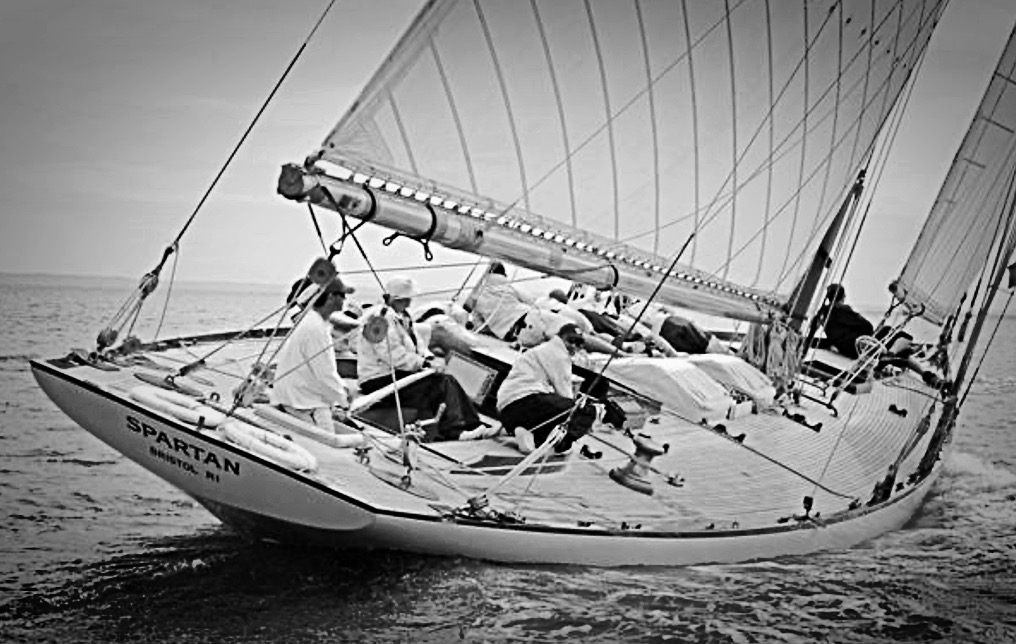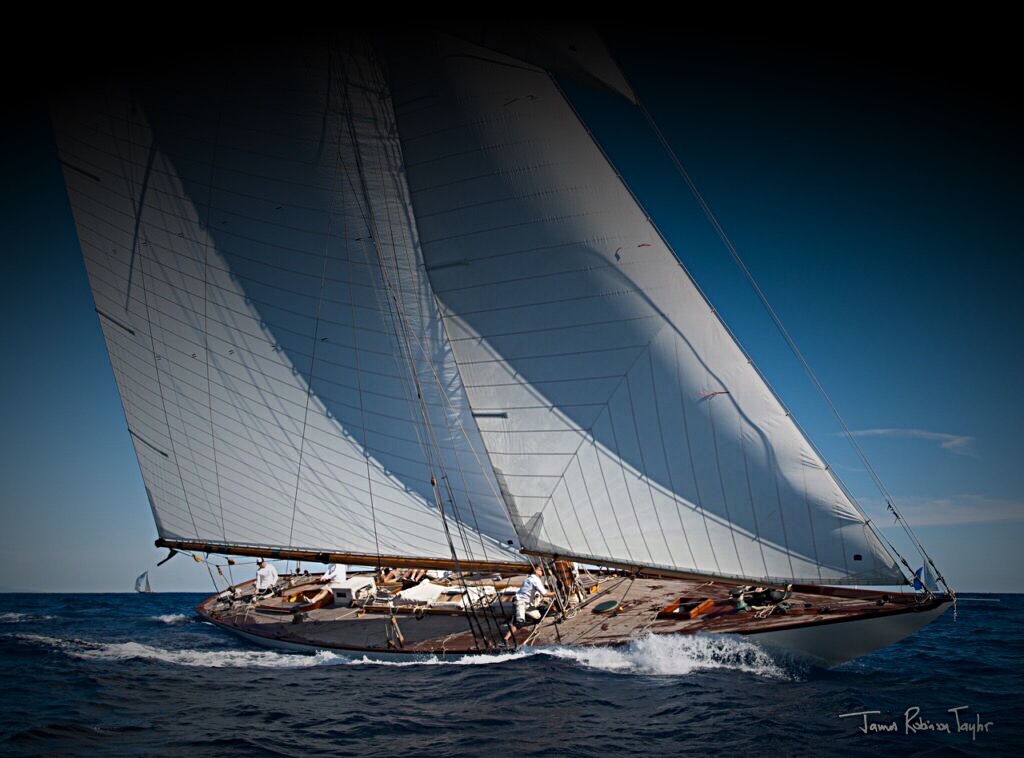
Sail Number: NY-6
Type: New York 50
“Spartan” Specifications:
LOA: 72′ 0″ / 21.94m – LWL: 50′ 0″ / 15.24m – Beam 14′ 7″ – 4.45m – Draft 9′ 9″ / 2.97m – Displacement: 74,000 lbs – Ballast: 35,500 lbs – Hull Number: 712 – Designer: N.G. Herreshoff – Original Owner: Edmund Randolph – Current Owner: Victor Paul – Built: 1912 – Contract Cost: $17,000 – Main Mast: 89’ 5” (hollow) Douglas fir – Sail Number: NY-6
Historical:
The fleet of NY50s was commissioned by the New York Yacht Club and built in the winter of 1912-1913 by the Herreshoff Manufacturing Company of Bristol (HMCo), Rhode Island. The boats were graceful yet powerful, comfortable in heavy weather and so swift that they won the Astor Cup for sloops 9 times.
Of the 9 NY50s built, the only known remaining vessel is Spartan (though Barbara may be out there somewhere, according to legend). Originally constructed as a jack yard tops’l gaff sloop, Spartan measures 72’ LOA and 50’ LWL. She has a 14’ 7” beam and a draft of 9’ 9”, displacing about 74,000 pounds. She carries 35,500 pounds of lead ballast.
Like her sisters, her topsides were double-planked and diagonally strapped for extra strength in the Herreshoff tradition; the hull was built upside down. Because they were constructed so efficiently, the NY50s only cost $17,000 to build.
Restoration
Allen Pease, Spartan’s owner at the time of her dismasting, had her towed to Brewer Pilots Point Marina in Westbrook, Connecticut. A survey revealed that a complete rebuild was needed. In 1981 he hired Ed McClave, Ben Philbrick and later Andy Giblin, who Pease knew would “do the job right” because of their collective experience in restoring Herreshoffs (24 in total, including Spartan) and other classic boats. The team worked on Spartan over the next 8 years as funds became available, and in the process formally established MP&G with headquarters in Mystic, Connecticut.
“We completed framing with steam-bent white-oak frames, replaced her floor timbers, her stem and part of her horn timber, and replanked her from the garboards to just below the sheer,” wrote McClave in a 2010 paper published by the Society of Naval Architects and Marine Engineers for the 4th Classic Yacht Symposium at the Herreshoff Marine Museum. In addition, her deck beams were replaced with white oak, and steel strapping was substituted for bronze to prevent future corrosion.
To reduce the commute time for MP&G, Pease had Spartan towed to Crocker’s Boatyard in New London. The restoration ceased in 1989, and 3 years later Spartan was moved by truck to the Herreshoff Marine Museum in Bristol, Rhode Island. There, she was set up as an exhibit while Pease looked for an appropriate buyer to finish the work he started. It took 18 years. “I had many offers from abroad and in the U.S., but I turned them all down until I met the current owners, who impressed me with their recently gained knowledge of all things Herreshoff, and their desire to have the restoration continue with MP&G, which was important to me,” said Pease.
Spartan’s owners, who wish to remain anonymous, wanted to maintain the boat’s original look without sacrificing safety. “I wanted the aesthetics of the boat to be such that it transports you back in time, so that when you sit on deck or go below you don’t see anything modern,” said one of the owners, who has restored a few houses in Scandinavia and 3 Buzzards Bay 30s, and was keen to test his skills on another classic boat.
In their search for reference materials to aid in the restoration, the owners tracked down old photographs and original drawings of Spartan and other NY50s from collections at Mystic Seaport, the Mariners Museum in Newport News, Virginia, and the Haffenreffer-Herreshoff Collection in the Hart Nautical Collection at the MIT Museum in Cambridge, Massachusetts.
The Restoration Continues:
The MP&G team renewed their work on Spartan in 2005, picking up where they had left off. They replaced the boat’s plywood deck covering with solid teak. They replaced the forefoot timber, the timber keel and the horn timber with white oak. They replaced all steel fastenings with silicon-bronze, including the floor timber bolts and chain plates. Because of significant water damage to the plank keel, most of it was replaced with a beautiful piece of knotless white oak measuring 12” thick by 27” wide.
The ballast keel was removed and sent to Canada to be repoured. The yellow pine covering boards were replaced with mahogany, and mahogany toe rails were added. Items like the capstan, binnacle and wheel were also restored.
For the interior, MP&G copied the panels from Pleione, another NY50 that had been partially salvaged by Mystic Seaport before being scuttled. Even the light fixtures were taken from 1915 patterns, the earliest period possible for electrical lights. “Spartan is not a museum artifact. She’s meant to be sailed as a racing boat, so everything we put on her was tested to destruction for maximum expected usage because we intend to sail her hard,” said one of her owners.
Skilled Craftsmen Pitch In:
While MP&G was the lead shop for this very extensive project, many subcontractors contributed their skills. For example, Taylor & Snediker, LLC of Pawcatuck, Connecticut, made the mahogany hatches with help from J.M. Reineck & Son of Hull, Massachusetts, who cast the bronze hardware. French & Webb of Belfast, Maine, built some 250 wooden shell blocks for the rigging that had been redesigned by MP&G from HMCo drawings. William Lowe Inc., of Rockland, Maine, produced the metal components. French & Webb also constructed Spartan’s hollow main mast, which measures 89’ 5” long and 13” at its widest diameter, from Douglas fir.
“There were literally hundreds of people involved in this project. It really was a labor of love because everybody went above and beyond in terms of craftsmanship, time and care,” said the owner. “She’s a special boat to sail, and I think everybody recognized that. Special boats seem to get extra attention.”
Stonington Boat Works, LLC in Stonington, Connecticut, built the 48’ boom, the 32’ gaff, the jack yards, and the mast hoops. “[They] built 20 mast hoops and my rigging crew leathered them. Everything that comes in contact with the wood on that vessel has a leather sleeve sewn around it to protect it from gouges,” said Nathaniel S. Wilson of Sailmaker, Inc. in East Boothbay, Maine, who built the standing and running rigging and made the sails from woven, synthetic, polyester sailcloth instead of Egyptian cotton, which was once commonplace.
Spartan is configured with a 450-square-foot jack yard tops’l; a 570-square-foot club jib; 3 different jib tops in various sizes; a nylon balloon jib for light air; and a 1970-square-foot mainsail designed with 2 reefs instead of its original single reef, for broader use. Because of Spartan’s narrow, efficient hull, and large sail area, she creates her own apparent wind and does very well in light air. “She has a self-tacking jib, so when you are head-to wind, you basically just turn her and go. You back the jib and her nose spins right around. As soon as she makes headway, she is completely maneuverable and handles like a dinghy. We sailed her off the mooring and off the dock,” said her owner.

Spartan Sails On:
The 2 owners sail Spartan with a crew of 10 and have worked with sailing master John Bardon. Bardon was brought to the U.S. from Europe to prepare the crew for racing and for the Med in 2012.
He has sailed on classic yachts most of his life. His resume includes the 214’ luxury yacht Creole; the Schooner Yacht America; the 178’ 3-masted topsail schooner Adix (formerly Jessica); and Shenandoah, another 3-masted schooner. “It’s a steep learning curve because nobody on the eastern seaboard has a gaff racer like this one,” said the owner, who has had limited sailing experience, but is determined to learn how to sail his own boat instead of hiring someone to do it for him. “It’s our boat. And if we win, we win by sailing her ourselves. There’s no achievement in paying people to do it for you. The people on the classic sailing circuit are great. It’s more of a collegial atmosphere instead of litigious. That’s why we got into it.”
The owners took Spartan on the racing circuit last summer (2011) starting in Maine, where they participated in the Eggemoggin Reach Regatta. There, they led the Herreshoff Class fleet at the twelfth annual Castine Classic Yacht Race to Camden, and took honors in all three races that also included the Camden Feeder Regatta. After Maine, Spartan returned to Nantucket to compete in the 39th Opera House Cup Regatta where she had been dismasted 31 years before. She placed third in her division. Next winter Spartan’s owners plan to take her to the Med to race against the Fifes where she is certain to do well.
“There is scuttlebutt over the NY50s being the greatest one-design class ever built. I certainly agree with that statement,” said Spartan’s former captain, John Wenz. “I have never sailed anything quite like her. She responds like a nimble modern ocean racer but yet has a solid feel of a classic yacht. She is all thoroughbred and all business. She wants to go fast all the time.”
Provenance (The Wall of Remembrance – The Owners, Crew & Notable Guest):
Owner/Guardian: (1912) – Edmund Randolph
Owner/Guardian: (1976) – Virgin Islands
Owner/Guardian: (1978-1993) – Allan Pease
Owner/Guardian: (1993-2006) – Pease/Herreshoff Museum
Owner/Guardian: (2015) – Victor Paul
Comments
Don Miller – July 11, 2018
I have two signed Morris Rosenfeld Photos of the Spartan undersail taken sometime in the 30’s when the Spartan was owned, and lived on, by the Homestead family. I have a third unsigned photo of the Homestead family at the helm. Rosenfeld was a family friend of the Homesteads, and I in turn am a friend of the Homestead’s son Dick who is a resident of Sausalito CA.
March 15, 2019
Hello, My sister and her husband, Dr. Ralph Wadeson, were partners in a partnership which owned the Spartan in the mid 70s. They are identified as “1976 Virgin Islands” in the history of ownership above. I am curious if you have a photo of the Spartan to sell since my only picture is very faded. She sure is a magnificent boat. Regards, Chris Hague
Cornelius Harrison – January 30, 2023
Hello
I was lucky enough to sail on the “Barbara” from Antigua to Dominica in 1976. Many good memories and I have some photos if you would like to see her. We were told the boat was heading to the west coast somewhere. I was telling the story of that sailing the other day and told the person it was a NY50. They had never heard of them. I decided to look it up and that brought me to your web page.
Thanks CC

Sir, my father owned a NY 50 in the late 1940s and I am interested in finding some information about her. My father’s name is Fred Silcox
She was schooner rigged with Marconie main, Gaff fore, and named Venture.
The last I saw her was in Larchmont, NY as she was sold to a Captain Rice.
That is about all the details I know. Any information would be greatly appreciated
Thank you very much